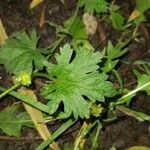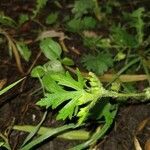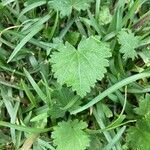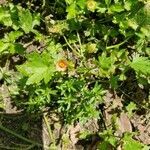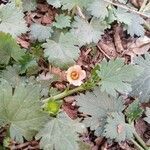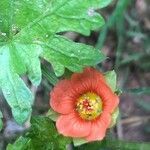Low, diffuse annual or biennial herb, up to 0.07 m high. Leaves simple, rounded, coarsely crenate to deep palmately lobed; stipules persistent. Flowers axillary, solitary, small. Epicalyx of 3 free, ± persistent bracts. Calyx ± deeply 5-fid; somewhat accrescent. Petals longer than calyx, red, rose or salmon-pink. Staminal tube divided at apex into many filaments, dilated towards base. Style branches as many as carpels, filiform; stigmas capitate. Flowering time Oct.-Feb. Fruit a schizocarp. Mericarps 15-20, usually 2-seeded, 2-awned, partly loculicidal, transversally septate between seeds. Seeds reniform.
Stems: flowering apices often ascending, branched, usually 0.2–0.5 m, often rooting at nodes. Leaves: stipules 3–4 × 1.5–3 mm; petiole length 1–2 times blade; blade 1.5–4 × 1.5–4 cm. Pedicels usually shorter than subtending petioles, hairy; involucellar bractlets lanceolate, 4–5 mm. Flowers: calyx 5–7 mm, hairy, hairs simple, 1–2 mm; corolla erect, 6–8 mm; staminal column yellowish; anthers crowded at apex; stigmas equaling number of locules. Mericarps drying black, 5–6 mm, apical spines 1.5–3 mm. Seeds 1.5 mm. 2n = 18.
Annual herb; scabrous. Stems procumbent, rooting at nodes. Leaves with blade suborbicular, palmately 3-7-lobed, 50-80 mm long, margins crenate. Flowers: epicalyx segments narrowly ovate; sepals broadly triangular-ovate; petals 3-5 mm long, slightly exceeding sepals, red; Sep.-Jan. Fruit with mericarps black, 2-awned.
Stems prostrate or ascending, often rooting at the nodes; lvs broadly ovate to subrotund, 3–5-cleft and irregularly incised; fls on elongate axillary pedicels; pet 3–5 mm; 2n=18. Moist or dry soil and waste places; tropical Amer., n. as a native to S.C. and reputedly Va., and occasionally farther as an adventive.
A herb. It can grow each year from seed or last for a few years. It forms roots at the nodes. It grows about 25 cm tall. The leaves are broadly oval and 3-4 cm long by 2-3 cm wide. There are 3-7 lobes. These have teeth. The flowers are red of orange. The fruit is a capsule 7-9 mm across.
Prostrate herb. Stems rooting at nodes. Stems and leaves scabrous. Leaves palmately lobed, lobes cre-nate. Carpels divided into 2 compartments by transverse partition. Flowers red.
